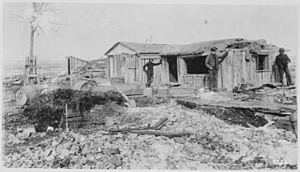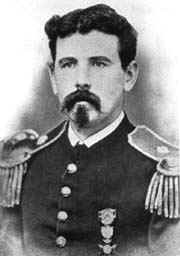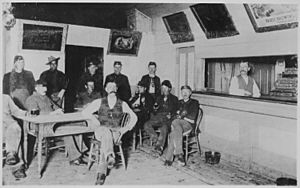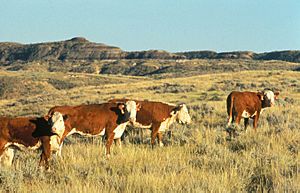Fort Keogh facts for kids
Quick facts for kids Fort Keogh |
|
|---|---|
| 2 miles (3.2 km) west of Miles City in Custer County, Montana | |
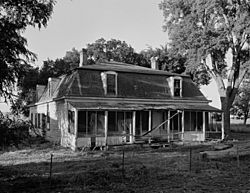
Officers' Quarters at Fort Keogh in 1989
|
|
| Site information | |
| Controlled by | United States |
| Site history | |
| Built | 1876 |
| In use | 1876–1924 |
| Battles/wars | Indian Wars |
|
Fort Keogh
|
|
| Nearest city | Miles City, Montana |
| Area | 10 acres (4.0 ha) |
| Built | 1877 |
| NRHP reference No. | 78001680 |
| Added to NRHP | March 8, 1978 |
| Garrison information | |
| Past commanders |
|
| Garrison |
|
Fort Keogh was once an important U.S. Army base in Montana. It's located near Miles City, right where the Tongue River meets the big Yellowstone River.
Colonel Nelson A. Miles started Fort Keogh in August 1876. He built it after the Battle of the Little Bighorn to help keep peace. The fort was a base for soldiers to patrol and encourage Cheyenne and Sioux tribes to settle on reservations.
For its first two years, it was called the Tongue River Cantonment. In 1878, it moved a mile west and was renamed Fort Keogh. This new name honored Captain Myles Keogh, who died at the Battle of the Little Bighorn. In 1877, Fort Keogh became the main office for the District of the Yellowstone. This area was part of the larger Department of Dakota, and Colonel Miles was in charge.
As the fort grew, traders and businesses started to appear nearby. This was the beginning of what is now Miles City. Today, Fort Keogh is no longer a military base. It's a United States Department of Agriculture research station. Here, scientists study livestock and rangeland. The fort is also listed on the National Register of Historic Places.
Contents
Building the Fort
After Lieutenant Colonel George Armstrong Custer's defeat at the Battle of the Little Bighorn in June 1876, the Army sent the 5th U.S. Infantry Regiment to eastern Montana. Colonel Nelson A. Miles led these troops. Their mission was to build a military fort. The order to build the fort was given on August 28, 1876.
The Army wanted the fort to help reduce conflicts with Native American tribes. They also hoped it would encourage tribes to move to reservations. Colonel David S. Stanley had explored the area in 1873. He thought it would be a good place to supply troops. However, the Army only decided to build the fort after Custer's big defeat.
As the Great Northern Railway planned to expand, the U.S. Army surveyed the land and made maps. During this time, soldiers met the Lakota (Sioux) and the Crow tribes. The Sioux had moved west, pushing the Crow from their traditional lands. Because of this, the Crow often helped the Army as scouts.
General Miles set up the "Cantonment Tongue River" where the Tongue River meets the Yellowstone River. This spot made it easy to get supplies by boat up the Yellowstone. For its first two years, the fort had different names. These included New Post on the Yellowstone and Tongue River Barracks. On November 8, 1878, the Army officially named it Fort Keogh.
Miles was a respected leader, even by some Native American tribes. He promised fair treatment and better lives. Slowly, he convinced many tribes to settle on reservations. But not all tribes surrendered right away. Miles and his troops fought against those who resisted, even in very cold winter weather. The Sioux and Crow tribes moved across large areas of Montana Territory. Soldiers often fought battles hundreds of miles from the fort.
In 1888, the 5th Infantry left Fort Keogh. The 22nd Infantry Regiment took over. Some of their companies had been there since 1876. The entire regiment moved to the fort in 1888 and stayed until 1896. Also in 1888, Company H of the 8th U.S. Cavalry arrived from Fort Davis, New Mexico. Company L of the 8th Cavalry joined them from Fort Hancock, Texas.
Who Was Myles Keogh?
Fort Keogh was named after Myles Keogh. He was a Captain and commander of Company I in the 7th U.S. Cavalry. He served under Lt. Col. George Armstrong Custer. Both were killed at the Battle of the Little Bighorn.
Myles Keogh was born in Ireland on March 25, 1840. He came from a comfortable family. But Keogh wanted adventure. In 1860, he went to Italy to fight to protect the Papal States. He earned two medals in those battles. Later, Keogh joined the Papal Guard in Rome.
Keogh preferred fighting to guarding. He left his post and went to the United States in March 1862. He joined the American Civil War on the Union Army side. He quickly showed his skill as a soldier. He earned many awards for his bravery. His courage at the Battle of Gettysburg earned him a higher rank. In 1863, Keogh took an assignment in the western wars. He served under Custer until his death in battle.
Keogh stood his ground, surrounded by Sioux warriors. His body was found among his soldiers. His horse, Comanche, was later found walking alone on the battlefield. Soldiers cared for the horse, and Comanche became famous.
How Miles City Grew
When the Army arrived, it created a need for businesses. Traders saw an opportunity. A town named Milestown grew, named after the fort's commander, Nelson A. Miles. It started as an army town to serve the young soldiers.
The Miles City Chamber of Commerce website shares a story about how the town began:
A man named Mat Carrol set up some barrels under a tarp and started selling goods. Colonel Miles found that this caused a lot of trouble for the fort. He ordered Carrol and other sellers to leave the military area.
An employee of Carrol's, John Carter, rode east until he was two miles (3 km) away. This was beyond the military land. He found a flat spot by the Yellowstone River. He built a small log hut from wood he found and continued his business. Soldiers soon found the place. Other merchants followed, and that's how Miles City started.
Milestown was a very lively place at first. Many soldiers visited its businesses. About a year after settling, General Miles moved the fort to its current spot. This was a couple of miles southwest of the original site. He hoped the extra distance from town would help reduce the unruliness. But the town simply moved closer to the new fort location.
In his book Recollections of Old Milestown, Samuel Gordon described a frontier event. Riverside Park, which is still there today, was rumored to be available for claiming. In the "Old West," if a man placed four logs on the ground in a square, he could claim the land. One person had placed two logs and went to get the other two. A second man saw the two logs and an opportunity. He placed his two logs with the first two. He expected the first man to leave. The second man said, "two logs counted nothing." But the first man pulled out his revolver. The second man quickly gave up his claim. Later that day, soldiers from the fort heard about the incident. They came out and sent all the people trying to claim land away.
Fort Keogh in the 1900s
In 1900, Fort Keogh became an army remount station. This meant it was a place where the Army trained and prepared horses. Infantry troops left the fort in 1907. During World War I, Fort Keogh became a quartermaster's depot. This means it was a supply center. The Fort Keogh remount station sent more horses for World War I than any other post. These horses were shipped all over the world.
The U.S. Department of the Interior took over the Fort Keogh military land in 1924. Since 2012, it has been the USDA Fort Keogh Range and Livestock Experiment Station. This station's Line 1 Hereford Herd has been very important in studying the genetics of Hereford cattle.
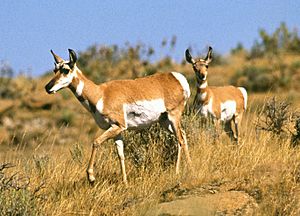
A law passed on April 15, 1924, changed who was in charge of the Fort Keogh Military Reservation. It was given to the U.S. Department of Agriculture. They would use it for experiments in raising livestock and growing crops for animal feed. Some original fort buildings still stand today. These include the parade ground, a wagon shed built in 1883, and the flagpole put up in 1887. There are seven other buildings from before 1924.
The original Fort Keogh Military Reservation was very large, about 100 square miles (64,000 acres). The Fort Keogh Livestock and Range Research Laboratory now covers about 55,357 acres. In 1878, a large piece of land east of the Tongue River was given up by the Army. This land is now where Miles City is located. Other parts of the land have been used for industrial sites, fairgrounds, a fish hatchery, and a recreation area.
About 1,800 acres are watered by the Yellowstone River. About 625 acres are used for crops, and 1,150 acres are irrigated pastures. The rest of the land is rough, broken badlands. This type of land is common where cattle are raised in the Northern Great Plains.
In 1954, the United States Air Force opened the 902nd Aircraft Control and Warning station. This station was about two miles south of the Yellowstone River. It was part of the Cold War air defense system. It helped protect the United States from possible attacks. The station operated until 1968. It closed because new radar technology made it unnecessary. Around 100 to 125 airmen and officers worked there.
The Range Riders Museum in nearby Miles City, Montana has exhibits about Fort Keogh's history.
Giant Snowflake Record
The Guinness World Records states that the largest natural snowflake ever recorded fell at Fort Keogh. It measured 15 inches (38 cm) across. This amazing event happened on January 28, 1887.
Images for kids




